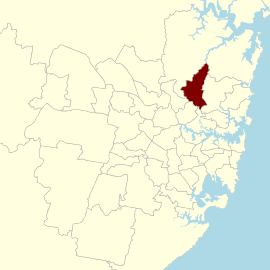Electoral district of Ku-ring-gai
| Ku-ring-gai New South Wales—Legislative Assembly | |||||||||||||||
|---|---|---|---|---|---|---|---|---|---|---|---|---|---|---|---|
 Location within Sydney | |||||||||||||||
| State | New South Wales | ||||||||||||||
| Created | 1973 | ||||||||||||||
| MP | Alister Henskens | ||||||||||||||
| Party | Liberal Party | ||||||||||||||
| Namesake | Kuringgai | ||||||||||||||
| Electors | 54,387 (2017)[1] | ||||||||||||||
| Area | 52.45 km2 (20.3 sq mi) | ||||||||||||||
| Demographic | Urban | ||||||||||||||
| |||||||||||||||
Ku-ring-gai is an electoral district of the Legislative Assembly in the Australian state of New South Wales. It is represented by Alister Henskens of the Liberal Party. The electorate covers the suburbs and parts of the suburbs of Gordon, Hornsby, Killara, Lindfield, Normanhurst, North Turramurra, North Wahroonga, Pymble, South Turramurra, Thornleigh, Turramurra, Wahroonga, Waitara, Warrawee, and West Pymble.[2]
Ku-ring-gai is the most advantaged area in Australia.[3]
Electorate history
Ku-ring-gai was created before the 1973 election and was held by Askin, Lewis and Willis government minister John Maddison, who retired in 1980. Future premier Nick Greiner won the seat at a by-election. He held the seat until resigning from Parliament and as Premier in 1992 in the aftermath of the ICAC enquiry into the Metherell affair. He was succeeded by Stephen O'Doherty, who in 1999 chose to follow the majority of his constituents into the re-created seat of Hornsby. Barry O'Farrell transferred to for Ku-ring-gai in 1999 after his seat of Northcott was abolished, and held it when he became Premier of New South Wales after leading the Coalition to a massive landslide victory in the 2011 state election. He resigned as premier in 2014 and retired from politics after the 2015 state election, handing the seat to current member Henskens.
Located in the Liberal heartland of the North Shore, Ku-ring-gai has been in Liberal hands for its entire existence, and for much of that time has been an ultra-safe seat even by North Shore standards. The Liberals have never tallied less than 65 percent of the two-party vote, and have always taken the seat on the first count with no need for preferences. At the 2011 election, for instance, O'Farrell was reelected with 81.3% of the two-candidate-preferred vote, making Ku-ring-gai the safest seat in the entire NSW parliament.
While Labor frequently runs dead in north Sydney, Ku-ring-gai is particularly hostile territory for Labor. Since the 1990s, Labor has usually been lucky to get 20 percent of the primary vote. In 2011, for example, Labor was pushed into third place behind the Greens.
Ku-ring-gai is one of three electorates in the New South Wales Legislative Assembly to have been held by two Premiers of New South Wales while in office. Both Premiers Nick Greiner and Barry O'Farrell have held Ku-ring-gai while in office, the other two electorates being Wollondilly and Maroubra.
The seat is almost entirely within the equally safe federal seat of Bradfield, the safest Liberal seat in the country.[4]
Members for Ku-ring-gai
| Member | Party | Period | |
|---|---|---|---|
| John Maddison | Liberal | 1973–1980 | |
| Nick Greiner | Liberal | 1980–1992 | |
| Stephen O'Doherty | Liberal | 1992–1999 | |
| Barry O'Farrell | Liberal | 1999–2015 | |
| Alister Henskens | Liberal | 2015–present | |
Election results
| Party | Candidate | Votes | % | ± | |
|---|---|---|---|---|---|
| Liberal | Alister Henskens | 30,294 | 62.5 | −10.3 | |
| Labor | David Armstrong | 7,927 | 16.4 | +8.5 | |
| Greens | Pippa McInnes | 7,650 | 15.8 | +1.9 | |
| Christian Democrats | John Archer | 1,375 | 2.8 | +0.7 | |
| No Land Tax | Len Gervay | 1,192 | 2.5 | +2.5 | |
| Total formal votes | 48,438 | 97.6 | −0.3 | ||
| Informal votes | 1,185 | 2.4 | +0.3 | ||
| Turnout | 49,623 | 92.8 | +1.8 | ||
| Two-party-preferred result | |||||
| Liberal | Alister Henskens | 31,954 | 73.0 | −13.9 | |
| Labor | David Armstrong | 11,832 | 27.0 | +13.9 | |
| Liberal hold | Swing | −13.9 | |||
References
- ↑ http://www.elections.nsw.gov.au/enrol_to_vote/enrolment_statistics
- ↑ http://www.elections.nsw.gov.au/districts/profiles/2015/Ku_ring_gai
- ↑ Gladstone, Nigel (2018-03-27). "Sydney's latte line exposes a city divided". The Sydney Morning Herald. Retrieved 2018-03-28.
- ↑ "(A bit late but a) Post-2016 Federal Election Pendulum plus Results Summary". ABC News. 2017-04-03. Retrieved 2018-03-28.
- ↑ State Electoral District of Ku-ring-gai: First Preference Votes, NSWEC.
- ↑ State Electoral District of Ku-ring-gai: Distribution of Preferences, NSWEC.
External links
- "Ku-ring-gai". New South Wales Electoral Commission. Retrieved 2017-10-07.